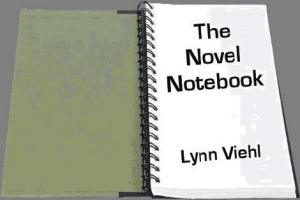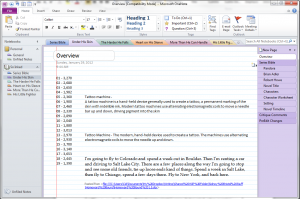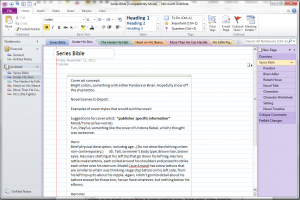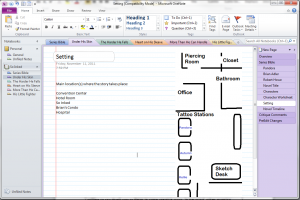 There once was a Writing Goddess known sometimes as Lynn Viehl, and she looked and saw other little writers aspiring to greatness, but unable to keep their plots and ideas in line. So the Writing Goddess gave the little writers a present – The Novel Notebook. And all the little writers were grateful, because the Writing Goddess was amazing.
There once was a Writing Goddess known sometimes as Lynn Viehl, and she looked and saw other little writers aspiring to greatness, but unable to keep their plots and ideas in line. So the Writing Goddess gave the little writers a present – The Novel Notebook. And all the little writers were grateful, because the Writing Goddess was amazing.
I’m being more than a little silly with my story there, but sometimes that is how I feel when I open up my novel notebook. I feel a great, huge wallop of thankfulness to Lynn Viehl for making it available to others. You might ask me, ‘Who is Lynn Viehl?’ She’s an author with over 40 novels published, some under a different name. I am most familiar with her Darkyn and Kyndred series, which are paranormal romance, but she also writes science fiction and has a YA series. I think that more than qualifies her for making this handy-dandy little tool I love soooo much!
What is the Novel Notebook you ask? Well that’s a good question! The Novel Notebook, if you use the template Lynn Viehl has provided or you create your own, is your story bible, it’s the repository for all of the information about your book in one place. I like to work with the template Lynn Viehl has provided simply because it has a) everything I need already organized and b) stuff I wouldn’t have even thought about if the template hadn’t prompted me to do so. Sometimes it’s that little information that adds another layer of depth to my writing.
I know from reading Lynn Viehl’s blog that she likes to print out the notebook and work with it in hardcopy. I’m a child of technology and I don’t like carrying around unnecessary binders or paper that always seems like it’s going to rip off the rings. So I took the Microsoft Office program OneNote and literally copied and pasted the template into that program. After some tidying up, removing of unnecessary lines, I have my own template. I’m not posting the template for download because the content isn’t mine to share. It’s easy to recreate from what is provided on Lynn Viehl’s blog. If OneNote isn’t your thing, I believe Word could work just as easily, with much the same results. Large amount of information, organized very well.
Maybe you don’t like this template, maybe you want to make your own. Are you one of those? That’s okay! I think the important thing is to keep track of your information, your characters, the nuances of the plot so that your characters are not holding a softball bat in one scene and you have no idea where or how they got it, because a few pages ago they were toting around popcorn!
If simplicity is your style, use a spiral notebook and sticky tabs and make lists. I always urge writers I chat with to take charge of their novels. Think of it like a business, if you will. If you’re a writer, chances are that you want to make writing a paying career path. Treat your material like you would your receipts or files; keep it organized however you like. And if you don’t have a method, I invite you to steal bits of mine!
Here are some screen shots of the Novel Notebook that I use. You’re only going to see the one for my book Under His Skin, as the others aren’t written yet, and I don’t want to spoil things completely. There are some tabs I’m not sharing because they contain plot information I also don’t want to spoil.
 I’m not covering the layout of OneNote in depth. I have a few blogs planned to talk about how I use the program. Right now I’m concerned with what’s inside of the pages. You can click on the images to enlarge them. You can see from the image that I’m in the Under His Skin tab of what is called a notebook in the program. What I’m sharing here is kind of my catch all page in the notebook. I paste random information here, and you can see where I began tracking the word counts of my chapters there on the left. That wound up changing, but you can get the idea of using a bit of scratch paper.
I’m not covering the layout of OneNote in depth. I have a few blogs planned to talk about how I use the program. Right now I’m concerned with what’s inside of the pages. You can click on the images to enlarge them. You can see from the image that I’m in the Under His Skin tab of what is called a notebook in the program. What I’m sharing here is kind of my catch all page in the notebook. I paste random information here, and you can see where I began tracking the word counts of my chapters there on the left. That wound up changing, but you can get the idea of using a bit of scratch paper.
 In the Series Bible section the information really gets started. I’ve used this to capture what I think my ideal cover art would look like. Authors don’t get a lot of say in these, but you do get one oportunity to give input, so make it count! I’ve tweaked this one to reflect how Ellora’s Cave gathers their information to do covers. Sometimes it’s even fun to go out into Paint or GIMP and create mock covers. I used to do this, but I wound up sinking way too much time into them when I couldn’t even really display them, so I stopped. But it never hurts to know what you want, just be willing to accept that you don’t always get it.
In the Series Bible section the information really gets started. I’ve used this to capture what I think my ideal cover art would look like. Authors don’t get a lot of say in these, but you do get one oportunity to give input, so make it count! I’ve tweaked this one to reflect how Ellora’s Cave gathers their information to do covers. Sometimes it’s even fun to go out into Paint or GIMP and create mock covers. I used to do this, but I wound up sinking way too much time into them when I couldn’t even really display them, so I stopped. But it never hurts to know what you want, just be willing to accept that you don’t always get it.
 The character tabs are probably some of the most frequently used by me. Not everyone is a fan of doing character bios and nailing down their information before a book starts, but for me this is vital. You can see from the screen shot here the basic info, physical description, her mother and father and step family. The whole bio goes on to detail her early life, some traumatic events that have happened and so forth.
The character tabs are probably some of the most frequently used by me. Not everyone is a fan of doing character bios and nailing down their information before a book starts, but for me this is vital. You can see from the screen shot here the basic info, physical description, her mother and father and step family. The whole bio goes on to detail her early life, some traumatic events that have happened and so forth.
I didn’t used to go looking for pictures to represent my characters. This is a fairly recent event for me, but I enjoy having them on file to glance at and visualize maybe what they’re wearing and how their facial expressions would contort their eyebrows or make their nose wiggle. It’s been a valuable visual que for me, especially with a large cast of characters.
 I find myself going back and adding to these as I write and add bits of history or back story. Favorite foods, physical tells, they’re really important to keep track of, especially with a series, as I’m finding out.
I find myself going back and adding to these as I write and add bits of history or back story. Favorite foods, physical tells, they’re really important to keep track of, especially with a series, as I’m finding out.
I’m sharing another view of a character sheet. This one is for the hero of the book, Brian. I used one of my favorite models as inspiration, and stole the snake tattoos he has going on and made them rattlesnakes for my book. Usually I have one character that has less going on than the other, but not so with these two!!
 There’s not a lot going on in this view, but sometimes there is. Titles are really difficult for me. Sometimes this sheet will be covered with key words, character traits, phrases, odd little things mentioned in a book I could bounce a title idea from and get something that really works. I forget how Under His Skin came to be, I think I gave up and asked for help. But, as you can see from this page, Under His Skin used to be called Homeward Bound, after something very near and dear to the hero’s heart. It didn’t fly, as I said, so I redid the title. When you’re with a publisher, they might want to avoid certain words or similar titles, so I have a note to myself to search the database for titles like what I want, so I know ahead of time if one will be difficult to live to publication.
There’s not a lot going on in this view, but sometimes there is. Titles are really difficult for me. Sometimes this sheet will be covered with key words, character traits, phrases, odd little things mentioned in a book I could bounce a title idea from and get something that really works. I forget how Under His Skin came to be, I think I gave up and asked for help. But, as you can see from this page, Under His Skin used to be called Homeward Bound, after something very near and dear to the hero’s heart. It didn’t fly, as I said, so I redid the title. When you’re with a publisher, they might want to avoid certain words or similar titles, so I have a note to myself to search the database for titles like what I want, so I know ahead of time if one will be difficult to live to publication.
 This is a fun one for me in this book. I get to draw out the places where my characters live or work. Here you can see the layout of the tattoo shop, So Inked, where a huge bulk of the story takes place. I’ve also listed different locations in the book. This is where I think Pinterest is a good tool, it would allow you to pin details of your setting to a board and have fun with it.
This is a fun one for me in this book. I get to draw out the places where my characters live or work. Here you can see the layout of the tattoo shop, So Inked, where a huge bulk of the story takes place. I’ve also listed different locations in the book. This is where I think Pinterest is a good tool, it would allow you to pin details of your setting to a board and have fun with it.
So that’s a quick overview of some of the sections of the Novel Notebook. There are more that cover governments, a plotting tool, and some other nifty things that don’t apply for what I’m currently working on.
Do you have an organizational method to your madness? Care to share?

I keep EVERYTHING in OneNote. I’ve got a section set up for research, and any time I find a new bit of research that I know I’ll need later, I pop it in. I’ve also got my own system that is similar to The Novel Notebook. I studied a bunch of other authors’ systems, took bits from this one and huge chunks from that one, and incorporated it all into my own working system. When I work on a series, each series has its own Notebook, complete with the series theme and characters and settings…and then individual novels get their own pages within the notebook. I’ve been using this for years now, and I keep having to rearrange how I’ve got it all organized in OneNote to make it make sense as everything I do grows and expands…but I can’t imagine working without it.
Oh yes, it’s been one of my greatest life savers! With all the research into the nuts and bolts of tattooing recently, it’s made my life much, much easier!
Sidney recently posted..The Novel Notebook
I keep my stuff in bins that hold hanging folders: character worksheets, diagrams of houses/buildings,pictures I’ve used for inspiration, etc. This has worked well for me, and I have a bin for each series I’ve worked on. The bins allow me the flexibility to stick in things that won’t fit in a notebook. For example, a book on horses that I used a lot when I was working on my fantasy series.
But I agree it’s important to find some system that works for you. I just learned of Lynn Viehl’s notebook a week or so ago and plan to adapt some of the features for my own use.
Great post!
Bins! That’s a great idea! I tried this, and I have an awesome thing that hangs on the wall for me to sort stuff in… and I never use it. I’ve learned that I roam and write. Since I don’t just write at home or in my office nook, I need to be more mobile.
Sidney recently posted..The Novel Notebook
One Note is amazing. It’s awesome that all my stuff is portable, since I write a lot in coffee shops and at your house. It does have some Pinterest like qualities since I can past in little tidbits I want or need.
I use about half of Lynn Viehl’s Novel Notebook, mostly after the book’s been written and I’m collecting information while I edit. I also use parts of Jim Butcher’s story skeleton and a couple other little things I
stoleborrowed from other authors.I think I may attempt to do a timeline since I always have trouble with that aspect. Time is never my friend. LOL
Suzan Butler recently posted..The mountains, Margie Lawson, EDITS, and a new outlook